The Victorian era had a lot of influences on Britain’s development. That era continued the ongoing prosperity of Britain. The Victorian era lasted from 1837 to 1901. It started with the accession of Queen Victoria. It ended with the queen’s death. Though the Victorian era ended in 1901, it left behind a lot of essential pieces of history. Many people are still in love with the Victorian era. They adore the fashion, architecture, and etiquette of that era.
Click Here if you want to pick an item of victorian clothing for you!
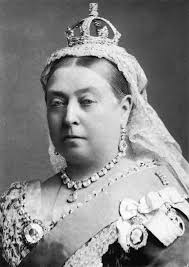
Among all the things of the Victorian era, their fashion interests most modern people. Some people like to wear Victorian-style dresses on Halloween and Ballade. Nowadays, many people arrange Victorian-style ball and social events. So, this is a perfect opportunity for many to try Victorian-inspired dresses. The victorian ballroom had many exciting things. The ballrooms were luxurious. Only well dressed upper-class people attended those events. Many fashion enthusiasts are in awe with the Victorian ball gowns.
Victorian Ballroom
The word “Ball” means “to dance.” It came from the Latin word “ballade.” The first recorded ballroom dance took place in the 16th century in France. But, ballroom dancing developed a lot in Britain. Ballroom dancing was arranged regularly in the Victorian era and early 20th century. There are a lot of illustrations available based on the 1840s to 1860s Victorian ball.
At face sight, Victorian Balls look like some social gathering. People may think that the Victorian upper-class people gathered there to dance and celebrate some happy occasions. But most of the time, the purpose of arranging ballroom dance was different. During the Victorian era, ballroom dances were organized to help people to find their prospective marriage partner. But the participants did not limit to unmarried people only. Both married and unmarried people were allowed to participate in these ballroom dancing.
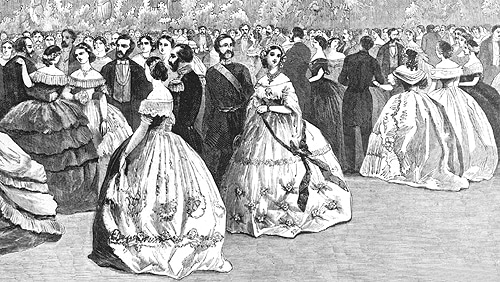
There were a lot of ways to organize a Victorian Ballroom during that era. Usually, it was held by the people who want to dance and are looking for their marriage partner. Prominent associations like Victorian military and fire engine companies also organized a ballroom for their officials in some evening. The organizer was in charge of procuring a hall, hiring musicians, preparing dinner, and sending invitations to the attendants.
Victorian ballroom followed some strict rules. In the ballroom, everyone tried to be on their best behavior. It was a duty to the participants to master the etiquette of the Victorian Ballroom. Any deviations from these rules were criticized and seen as a character flaw. Both married and unmarried women attended these ballroom dances. But the married women are not allowed to dance. They were there to accompany their husband or daughter. Women who recently lost their husbands could also attend these parties. But these mourning women were not allowed to dance as well.
The rules were not limited to participation and manner. There were some rules for dancing too. Men could not just ask any women for a dance. Sometimes, unmarried women had a dance card. Her potential dance partner was selected before the dance. Unmarried women were usually accompanied by their mothers or prospective marriage partner. Their mother tried to remain close to there daughter. They were there to refrain their daughter from any unwanted behaviors.
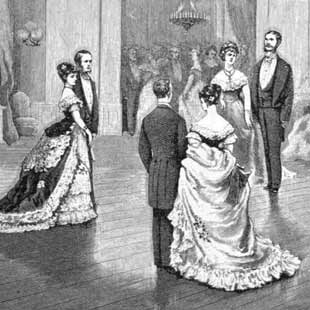
Women had the right to deny anyone if they did not want to dance with them. But most of the time, they danced with anyone who asked for a dance. If a woman denied anyone for a dance request, she had to refuse it politely without hurting the man. Because the man considered the reason for the denial as his lackings, the man could not force any unwilling women to dance with them.
Most of the time, the Victorian ballroom followed quadrille dances. Quadrille dances were danced in a two to four groups. The group of couples formed a square and danced with their partner. They danced with the music and took turns to dance with other people in that group. Usually, a man danced with a woman only once during the whole night.
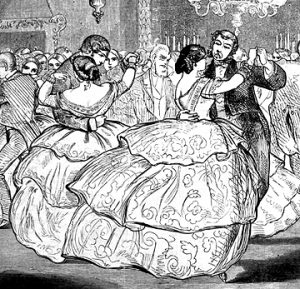
Victorian Ball Gowns
Victorian Ball Gowns were similar to the Victorian women’s evening dresses. The design gowns were the same as the clothing of the upper-class women. But the color choice was different than the usual dresses. Ballroom gowns were expensive and reflected the social class of a woman. So, the participant did not hesitate to put on their most expensive dresses. Most of the time, only rich upper-class people attended these ballroom events.
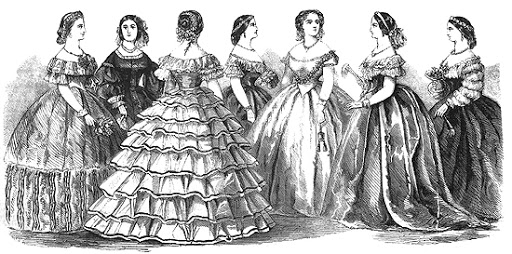
Some people may confuse ballroom gowns as a one-piece dress. But there were several parts on the gowns. Women wore a crinoline in the lower body. For the upper body, they wore a bodice or chemisette. Over the bodice, they wore a tight corset. At the time, the ideal frame for women was a tight waist and full bottoms. So, The reason for wearing this kind of dress was to achieve their perfect body shape. The tight corset emphasized a narrow waist. And the full beehive-like crinoline gave the illusion of a wide hip.
Ballroom Gowns Design
The ballroom gowns design changed a few times during the Victorian era. But a few things remain more or less constant. The neckline of these ballroom gowns was quite low. These low necklines were called bertha. These necklines exposed women’s shoulders. This low neckline was straight at the beginning of the Victorian era. But over a decade, they got into a v-shaped neckline and got even lower. The corset, bodice, and chemisette design remained more or less the same. The crinoline was replaced by the caged-crinoline. But from outside, they looked the same.
Victorian women’s ballroom gown had the same design for every woman. But the gown color and fabric were different based on their marital status. There was some distinct difference between the married and unmarried women’s gowns.
Unmarried Women
The primary purpose of an unmarried woman to attend a ball was to find her potential husband. So their dresses were very distinctive than the married women. Unmarried women wore light-colored outfits with some jewelry. The standard fabric choice for their dresses was gauze, tulle, net, fishnet muslin, and other similar fabrics. They were not allowed to wear silk. The women wore lighter dresses because they had to dance. That was the reason to avoid more massive silk dresses.
People considered these light-colored clothing as a symbol of purity and innocence. The young women’s ballroom dress was light and allowed them to walk and dance comfortably. So, they had no problem wearing those dresses.
Married Women
Married women can wear heavy silk dresses. But the color of their gowns was also light. The could wear more jewelry than unmarried women. The Victorian ball was considered a happy occasion. For that reason, married women tried to avoid any color that was considered as gloomy—the decision to dress in a way that was appropriate for the dining table.
Mourning Women
Victorian widows wore a black dress after the death of their husbands. They were expected to mourn around 4 to 18 months. Victorian women who recently lost their husbands were also allowed to attend Victorian Ball. Their dressing color reflected their husband’s death. They wore black, violet, or scarlet dresses. They did not dance on these events.
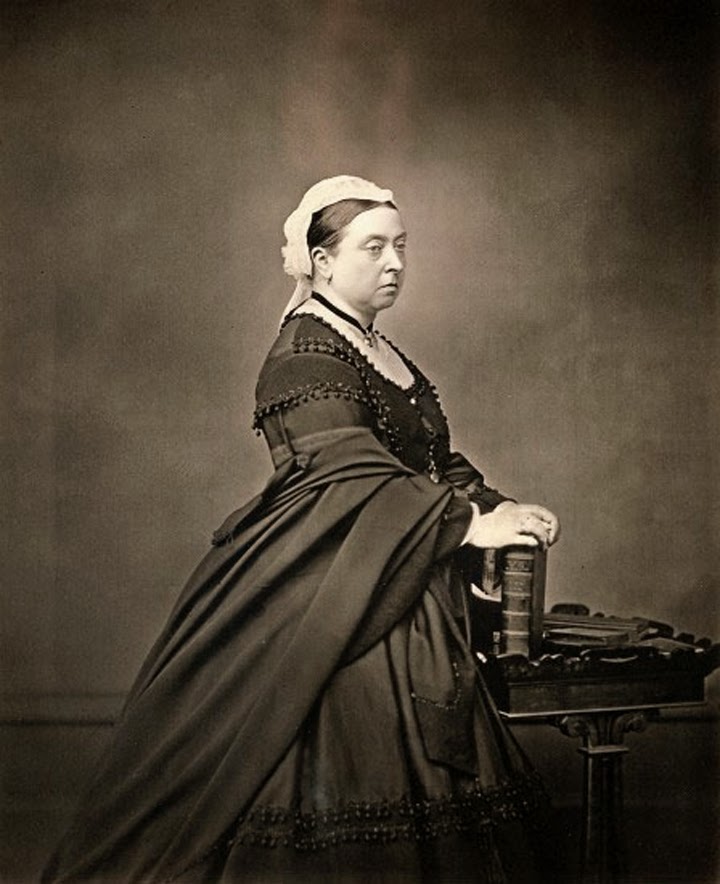
Ballroom Gown Changes over the years
It is hard to indicate any concrete change of ballroom gown during the Victorian era. Most illustration of the Victorian ball had the dresses from the 1840s to 1860s. But the women’s dressing changed a lot during the 1870s. During that time, women started to wear high neckline dresses. And the crinoline was replaced by the bustle. So, it is safe to assume that ballroom gown also changed during the decades. The majority of the balls were an evening event. Women most likely wore that era’s evening dresses at these ballroom events.
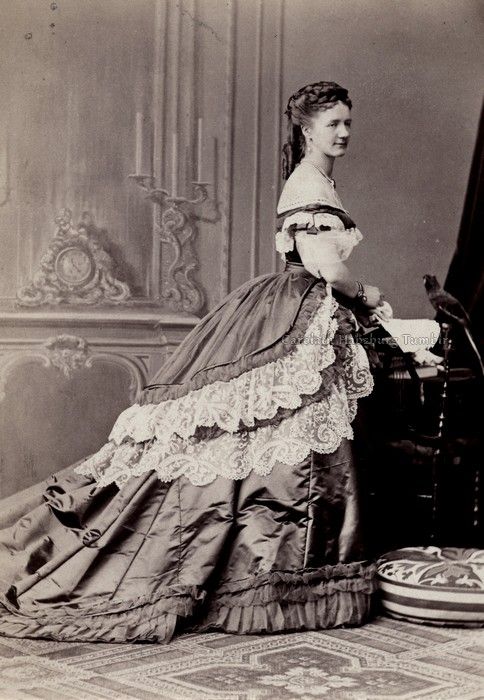
Victorian Ball gowns for modern Victorian style Ball
Nowadays, some places hold Victorian style balls as a celebration party. The purpose of these events may change, but the clothing choice remains the same. With the resurgence of the online shop, it is effortless to find a Victorian-style ballroom gown. But these gowns are not exactly like the Victorian era dresses. They only imitate the look of the Victorian era women’s dresses. The good thing is these new dresses are more comfortable than the Victorian era dresses. They are quite cheap. And you can choose any color you want. Now, the new Victorian-style ball does not have color and fabric restriction like a Victorian ball.
Conclusion
Victorian ball gowns were undoubtedly impressive. Many people like the fact of different color gowns of the women based on their marital status. This type of marriage meeting is unheard of in modern society. But Victorian ball certainly piques the interest of the Victorian era enthusiasts.

